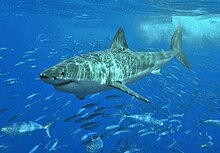板鰓亞綱
| 板鰓亞綱 化石時期:
| |
|---|---|

| |
| 大白鯊 | |
| 科學分類 | |
| 界: | 動物界 Animalia |
| 門: | 脊索動物門 Chordata |
| 綱: | 軟骨魚綱 Chondrichthyes |
| 亞綱: | 板鰓亞綱 Elasmobranchii Bonaparte, 1838 |
| 目 | |
| |
板鰓亞綱(學名:Elasmobranchii)屬於軟骨魚綱,包括鯊魚和鰩。魚鰓是板狀,鰓裂 5-7 對,鰓間隔寬大。體外是盾鱗或光滑,雄性腹鰭轉化為鰭足,沒有魚鰾,仰賴富含油脂的魚肝維持浮力。
最早的板鰓亞綱公認化石發現於志留紀,現存大部分的目多在侏儸紀之後出現。許多早期種類在二疊紀末期中絕種,也因此導致在侏儸紀時發生輻射適應。
描述
[編輯]板鰓亞綱為軟骨魚綱下的兩個亞綱之一,另一個為全頭亞綱(銀鮫)。鰓裂 5-7 對,體外是盾鱗,沒有魚鰾,眼睛具有脈絡膜層,雄性腹鰭特化為鰭足。板鰓亞綱遍佈於熱帶與溫帶的水域中[2]。
許多魚類仰賴魚鰾維持浮力,但沒有魚鰾的板鰓亞綱物種則透過富含油脂的魚肝來維持浮力[3]。這些油脂在食物短少時也能作為暫時的營養來源[4][5]。其中深海鯊魚的肝重量可達體重 20%[6],常被視為是漁業捕獲的目標。
演化歷程
[編輯]目前最早已知確認屬於板鰓亞綱總群的演化支為亮齒鯊屬,生存於約3.83億年前的中泥盆紀(晚吉維特期)時期[7]。其他較著名的板鰓亞綱總群演化支,如櫛棘鯊目與弓鯊目,則是於晚泥盆紀(法門期)出現[8]。
石炭紀時期,部分櫛棘鯊目物種體長已可達7公尺(23英尺),與現存的大白鯊相當[9]。在石炭紀及二疊紀時期,異刺鯊目同時活躍於淡水及海洋生態系,直到三疊紀物種多樣性才逐漸遞減[10]。弓鯊目在二疊紀時期具有十分高的物種豐富度[11],且直到三疊紀至早侏儸紀時期前都是由弓鯊目占了板鰓亞綱物種的大多數,牠們同樣也同時活躍於淡水及海洋生態系中[12]。
三疊紀時期,狹義的板鰓亞綱(新鯊類,包含了現存的鯊總目及鰩總目)出現,但牠們一直到早侏儸紀才逐漸多樣化,現存的鯊魚及鰩魚演化支也大多是於此時出現[13]。與此相反的是,弓鯊目的物種豐富度卻是隨著時間遞減,直到晚侏儸紀時,在海洋中已幾乎不存在弓鯊目的物種,但牠們於淡水環境中直到白堊紀時期仍十分常見[14],目前已知最後的弓鯊目物種存到了白堊紀晚期[15]。
分類
[編輯]本亞綱現存種類主要有兩大類:鯊類和鰩類,分為如下各目:
包括已滅絕種類的分類:
- †Plesioselachus
- †似扁鯊目 Squatinactiformes
- †原尖齒鯊目 Protacrodontiformes
- †異棘鯊總目 Xenacanthimorpha
- †異棘鯊目 Xenacanthiformes
- 鯊鰩下綱 Euselachii
其他:
- † Aellopobatis 屬
- Aellopobatis bavarica Türtscher, Jambura, Villalobos-Segura, López-Romero, Underwood, Thies, Lauer, Lauer & Kriwet, 2024[16]
參考文獻
[編輯]- ^ Märss, Tiiu; Gagnier, Pierre-Yves. A new chondrichthyan from the Wenlock, Lower Silurian, of Baillie-Hamilton Island, the Canadian Arctic. Journal of Vertebrate Paleontology. 2001, 21 (4): 693–701. doi:10.1671/0272-4634(2001)021[0693:ANCFTW]2.0.CO;2.
- ^ Bigelow, Henry B.; Schroeder, William C. Fishes of the Western North Atlantic. Sears Foundation for Marine Research, Yale University. 1948: 64–65. ASIN B000J0D9X6.
- ^ Oguri, M (1990) "A review of selected physiological characteristics unique to elasmobranchs" (頁面存檔備份,存於網際網路檔案館) In: Elasmobranchs as living resources: advances in the biology, ecology, systematics and the status of the fisheries, eds. J. H. L. Pratt, S. H. Gruber and T. Taniuchi, US Department of Commerce, NOAA technical report NMFS 90, pp.49–54.
- ^ Hoenig, J.M. and Gruber, S.H. (1990) "Life-history patterns in the elasmobranchs: implications for fisheries management" (頁面存檔備份,存於網際網路檔案館) In: Elasmobranchs as living resources: advances in the biology, ecology, systematics and the status of the fisheries, eds. J. H. L. Pratt, S. H. Gruber and T. Taniuchi, US Department of Commerce, NOAA technical report NMFS 90, pp.1–16.
- ^ Bone, Q.; Roberts, B. L. The density of elasmobranchs. Journal of the Marine Biological Association of the United Kingdom. 2009, 49 (4): 913. doi:10.1017/S0025315400038017.
- ^ Vannuccini, Stefania (2002) Shark liver oil products (頁面存檔備份,存於網際網路檔案館) In: Shark Utilization, Marketing and Trade, Fisheries Technical paper 389, FAO, Rome. ISBN 92-5-104361-2.
- ^ Frey, Linda; Coates, Michael; Ginter, Michał; Hairapetian, Vachik; Rücklin, Martin; Jerjen, Iwan; Klug, Christian. The early elasmobranch Phoebodus : phylogenetic relationships, ecomorphology and a new time-scale for shark evolution. Proceedings of the Royal Society B: Biological Sciences. 2019-10-09, 286 (1912): 20191336. ISSN 0962-8452. PMC 6790773
 . PMID 31575362. doi:10.1098/rspb.2019.1336 (英語).
. PMID 31575362. doi:10.1098/rspb.2019.1336 (英語).
- ^ Schultze, H.-P., Bullecks, J., Soar, L. K., & Hagadorn, J. (2021). Devonian fish from Colorado’s Dyer Formation and the appearance of Carboniferous faunas in the Famennian. In A. Pradel, J. S. S. Denton, & P. Janvier (Eds.), Ancient Fishes and their Living Relatives: a Tribute to John G. Maisey (pp. 247–256.). Verlag Dr. Friedrich Pfeil.
- ^ Maisey, John G.; Bronson, Allison W.; Williams, Robert R.; McKinzie, Mark. A Pennsylvanian 'supershark' from Texas. Journal of Vertebrate Paleontology. 2017-05-04, 37 (3): e1325369. Bibcode:2017JVPal..37E5369M. ISSN 0272-4634. S2CID 134127771. doi:10.1080/02724634.2017.1325369 (英語).
- ^ Pauliv, Victor E.; Martinelli, Agustín G.; Francischini, Heitor; Dentzien-Dias, Paula; Soares, Marina B.; Schultz, Cesar L.; Ribeiro, Ana M. The first Western Gondwanan species of Triodus Jordan 1849: A new Xenacanthiformes (Chondrichthyes) from the late Paleozoic of Southern Brazil. Journal of South American Earth Sciences. December 2017, 80: 482–493. Bibcode:2017JSAES..80..482P. doi:10.1016/j.jsames.2017.09.007 (英語).
- ^ Koot, Martha B.; Cuny, Gilles; Tintori, Andrea; Twitchett, Richard J. A new diverse shark fauna from the Wordian (Middle Permian) Khuff Formation in the interior Haushi-Huqf area, Sultanate of Oman. Palaeontology. March 2013, 56 (2): 303–343. Bibcode:2013Palgy..56..303K. ISSN 0031-0239. S2CID 86428264. doi:10.1111/j.1475-4983.2012.01199.x (英語).
- ^ Rees, J. A. N., and Underwood, C. J., 2008, Hybodont sharks of the English Bathonian and Callovian (Middle Jurassic): Palaeontology, v. 51, no. 1, p. 117-147.
- ^ Underwood, Charlie J. Diversification of the Neoselachii (Chondrichthyes) during the Jurassic and Cretaceous. Paleobiology. March 2006, 32 (2): 215–235. Bibcode:2006Pbio...32..215U. ISSN 0094-8373. S2CID 86232401. doi:10.1666/04069.1 (英語).
- ^ Rees, Jan; Underwood, Charlie J. Hybodont Sharks of the English Bathonian and Callovian (Middle Jurassic). Palaeontology. January 2008, 51 (1): 117–147. Bibcode:2008Palgy..51..117R. ISSN 0031-0239. doi:10.1111/j.1475-4983.2007.00737.x
 (英語).
(英語).
- ^ Carrillo-Briceño, Jorge D.; Cadena, Edwin A.; Dececchi, Alex T.; Larson, Hans C. E.; Du, Trina Y. First record of a hybodont shark (Chondrichthyes: Hybodontiformes) from the Lower Cretaceous of Colombia. Neotropical Biodiversity. 2016-01-01, 2 (1): 81–86. Bibcode:2016NeBio...2...81C. ISSN 2376-6808. doi:10.1080/23766808.2016.1191749 (英語).
- ^ Julia Türtscher, Patrick L. Jambura, Eduardo Villalobos-Segura, Faviel A. López-Romero, Charlie J. Underwood, Detlev Thies, Bruce Lauer, René Lauer and Jürgen Kriwet. 2024. Rostral and Body Shape Analyses reveal Cryptic Diversity of Late Jurassic batomorphs (Chondrichthyes, Elasmobranchii) from Europe. Papers in Palaeontology. DOI: 10.1002/spp2.1552

